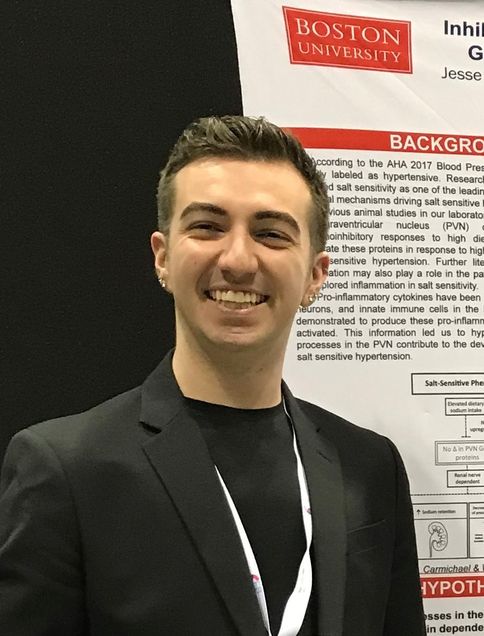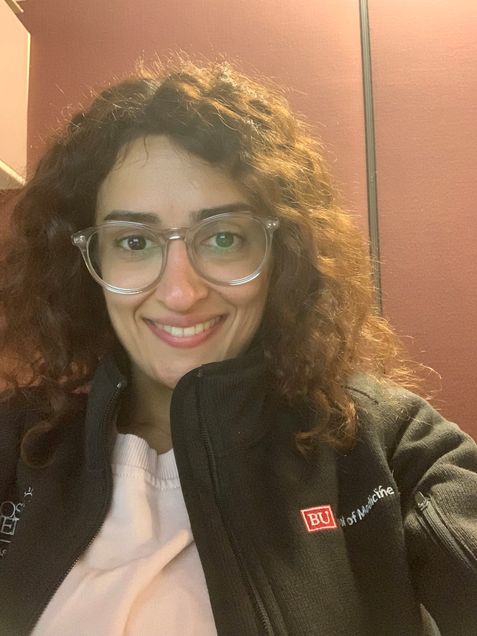
Jesse Moreira, PhD, MS
(May 2021 – Present)
Mentors: Darrell Kotton, MD and Jessica Fetterman, PhD
Heart failure is increasing rapidly, with the U.S. prevalence projected to reach 8 million by 2030. Five-year survival rates for patients with heart failure are 50%, which is worse than most cancers. Heart failure encompasses a number of disease subtypes with significant heterogeneity in both phenotype and therapeutic responses but the underlying contributors to the clinical heterogeneity in heart failure is not well understood.
Of interest to us, mitochondrial abnormalities have long been noted in heart failure, but whether mitochondrial genetic variation contributes to HF subtypes is unknown. The goal of Dr. Moreira’s research is to identify the underlying mechanisms whereby genetic mutations within the oxidative phosphorylation (OXPHOS) subunits lead to perturbations in metabolism and cardiomyocyte dysfunction.
Under the multi-disciplinary mentorship of Drs. Jessica Fetterman, Darrell Kotton, and Deepa Gopal, Dr. Moreira is developing and optimizing a protocol for the differentiation of cardiomyocytes from induced pluripotent stem cells (iPSC) obtained from Framingham Heart Study patients.
Dr. Moreira will generate iPSC-derived cardiomyocytes with point mutations previously identified as causal variants of mitochondrial cardiomyopathies using CRISPR-Cas9 techniques. He will evaluate cardiomyocyte phenotype and mitochondrial function in the edited and unedited cardiomyocytes in order to gain mechanistic insight into the role of OXPHOS genetic variation in cardiac metabolism and function.
Our studies may reveal novel, targetable mechanistic pathways resulting from aberrant nuclear/mitochondrial interactions in heart failure that can be exploited as treatment options in patients. Moreover, in conjunction with his PhD training in whole animal, integrative cardiovascular pathophysiology, Dr. Moreira’s project will enable him to probe the relations between mitochondrial biology and the progression of heart failure, enhancing his strength as a cardiovascular researcher.
Publications
Moreira, JD., Gopal, DM., Kotton, DN., Fetterman, JL. (2021) “Gaining Insight into Mitochondrial Genetic Variation and Downstream Pathophysiology: What Can i(PSCs) Do?” Genes (Basel) 12(11), 1668; https://doi.org/10.3390/genes12111668

Madelyn Ray, PhD
(July 2021 – Present)
Mentors: Ryan Logan, PhD
Opioid use disorder (OUD) diagnoses and deaths from opioid overdoses have skyrocketed in the United States over the recent decade. Recent studies have found links between chronic opioid use and cardiovascular diseases, especially myocardial infarction. In addition, chronic and recurrent opioid use has severe consequences on neurovasculature integrity in the brain. Dr. Logan’s laboratory has recently discovered an enrichment of transcripts related to endothelial cells in the brains of people with OUD in key brain regions involved in addiction. Transcripts were also enriched for processes related to neurovascular integrity, such as blood-brain barrier gap junctions and active transport mechanisms. These findings from the human brain provide further support for changes in neurovasculature associated with OUD.
The goal of Dr. Ray’s research is to answer the following research questions:
1) Does chronic opioid administration in mice lead to alterations in neurovascular integrity? Dr. Ray will perform acute or chronic administration of opioids in mice, after which brains will be harvested to examine markers for neurovascular integrity and blood-brain barrier functions using transcriptomics, RNA-seq.
2) Does neurovascular uncoupling alter dopamine neurotransmission in reward-related brain regions? Dr. Ray will treat mice with epoxygenase inhibitor N-(methylsulfonyl)-2-(2-propynyloxy)-benzenehexanamide (MSPPOH), the NO synthase inhibitor l-NG-Nitroarginine methyl ester (L-NAME), and the COX inhibitor indomethacin to induce a reduction in neurovascular coupling. Mice will then undergo fiber optic implantation to record dopamine transients using fiber photometry between the midbrain and striatum, areas of the brain important for opioid reward and dependence.
3) Does neurovascular uncoupling modulate opioid reward, tolerance, and withdrawal behaviors in mice? Dr. Ray will treat mice with epoxygenase inhibitor N-(methylsulfonyl)-2-(2-propynyloxy)-benzenehexanamide (MSPPOH), the NO synthase inhibitor l-NG-Nitroarginine methyl ester (L-NAME), and the COX inhibitor indomethacin to induce a reduction in neurovascular coupling. Mice will then undergo behavioral testing in opioid self-administration paradigms, including oral operant self-administration and intravenous self-administration to examine opioid seeking, craving, and relapse behaviors.

Leili Behrooz, MD
(July 2021 – Present)
Mentors: Naomi Hamburg, MD
Type 2 diabetes mellitus is a key public health problem worldwide with current trends predicting that 500 million people will have diabetes in 2035. The escalating prevalence of type 2 diabetes worldwide presents a critical cardiovascular challenge. Patients with type 2 diabetes experience accelerated vascular aging, premature atherosclerotic cardiovascular disease, and increased rates of cardiovascular events. There is considerable interest in the clinical cardiovascular benefits of new agents to treat type 2 diabetes including sodium-glucose cotransporter-2 (SGLT2) inhibitors such as dapagliflozin. However, the mechanisms of cardiovascular activity remains incompletely understood. Metabolic disturbances underlie the systemic vascular dysfunction in type 2 diabetes. Elevated glucose and lipids alter signal transduction thereby changing gene expression resulting disturbing endothelial homeostasis. Alterations in endothelial function including inflammation and reduced nitric oxide production promote atherogenesis in diabetes.
Several studies suggest activity of SGLT2 inhibitors on vascular function in animal models and humans. The robust clinical trial evidence with these classes of diabetes medications has not yet been accompanied by complete mechanistic evidence in the vasculature.
Combining vascular functional assessment with targeted endothelial cell gene expression and nitric oxide characterization will expand critical evidence about the mechanisms of action. Prior clinical studies evaluating the effects of SGLT-2 inhibitors have been limited to evaluation of vascular health without measures of endothelial cell phenotype that will provide additional mechanistic information. Dapagliflozin, a SGLT2 inhibitor, has effects on endothelial cell inflammation in cultured cells and improved vasodilation in animal models; however the effect on endothelial cell health in patients is not well-defined. Emerging experimental evidence in preclinical models also links SGLT2 inhibitors to reduction in mitochondrial oxidative stress.
We aim to investigate treatment with a SGLT2 inhibitor for diabetes will alter endothelial cell phenotype and ncRNA or biomarkers. We plan to test this hypothesis by conducting an interventional crossover study with dapagliflozin. We anticipate that evaluating endothelial cell phenotype will provide key additional information regarding the ability of novel treatments for type 2 diabetes to restore vascular health. Our study will provide novel evidence about endothelial cell effects of dapagliflozin that link to both animal models of diabetes and clinical trial data.
